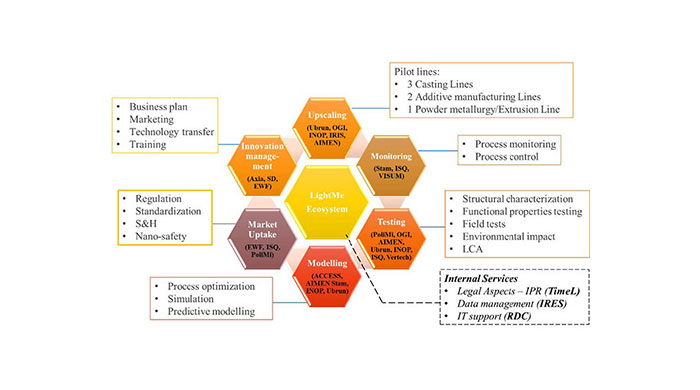Lightweight materials have become increasingly critical for producing components for aircrafts, cars,
trains, ships,
and defence equipment. Especially, lightweight metal and alloys possess high strength-to-weight
ratios and low
density.
Common applications are met in the automotive, aerospace, manufacturing, railway and other
large
niche applications.
For example, lighter vehicles consume less fuel, emit less harmful gases and provide a better
performance.
It should be noted that the aforementioned sectors (based on recent Eurostat data) are of crucial
importance for the European Manufacturing Industry providing more than 6 million jobs and
contributing ~11% to the EC-28 GDP.
As lightweight metals we consider aluminum, magnesium, and titanium
alloys. Moreover, metal matrix composite materials that traditionally
incorporate micron scale reinforcements in a bulk metallic matrix offer opportunities to tailor
material properties such as hardness, tensile strength, thermal stability, ductility, density,
thermal and electrical conductivity, and wear resistance.
With the advent of nanomaterials, nanocomposites are envisioned, and are being developed,
with properties that overcome technical limitations of pure metals or composites that contain micron
scale reinforcements. In the past decade, much work has been done towards developing polymer matrix
nanocomposites and such materials are already used in various applications.
The LightMe project aspires to be a point of reference for boosting innovation in the field of lightweight metal matrix nanocomposites (MMnC) setting up an Open Innovation Ecosystem (test bed) that will boost the introduction of new functionalities, features and capabilities to lightweight metals. The LightMe Ecosystem will provide the necessary infrastructure (6 Pilot Lines – PL) and knowhow for upscaling the new materials concepts related to lightweight MMnC and advance materials, in a cost effective and sustainable way.

Besides the upscaling units the Ecosystem will provide services
including monitoring, testing, modelling & simulation, standardization, regulatory compliance,
nanosafety and innovation management (IM)addressing the industrial needs of SMEs and large
enterprises that will access the Ecosystem and thus, ensuring the technology transfer to the
market.
The LightMe ecosystem will consist of 17 core aligned and complementary
partners, members of the LightMe consortium, established in 11 EC countries and will offer open,
non-discriminated access to clients, including SMEs and start-ups, acting as a one stop shop. The
LightMe ecosystem will be represented by a legal entity – a Non for Profit Organization (NPO) – that
will be the Single Entry Point for the customers – and will have the mandate to sign contracts on
behalf of the Ecosystem. The positioning of LightMe in the innovation value chain will allow to
function as a bridge between upstream (material developers and knowhow suppliers as Universities and
Research Centers) and
downstream (end users) industries.